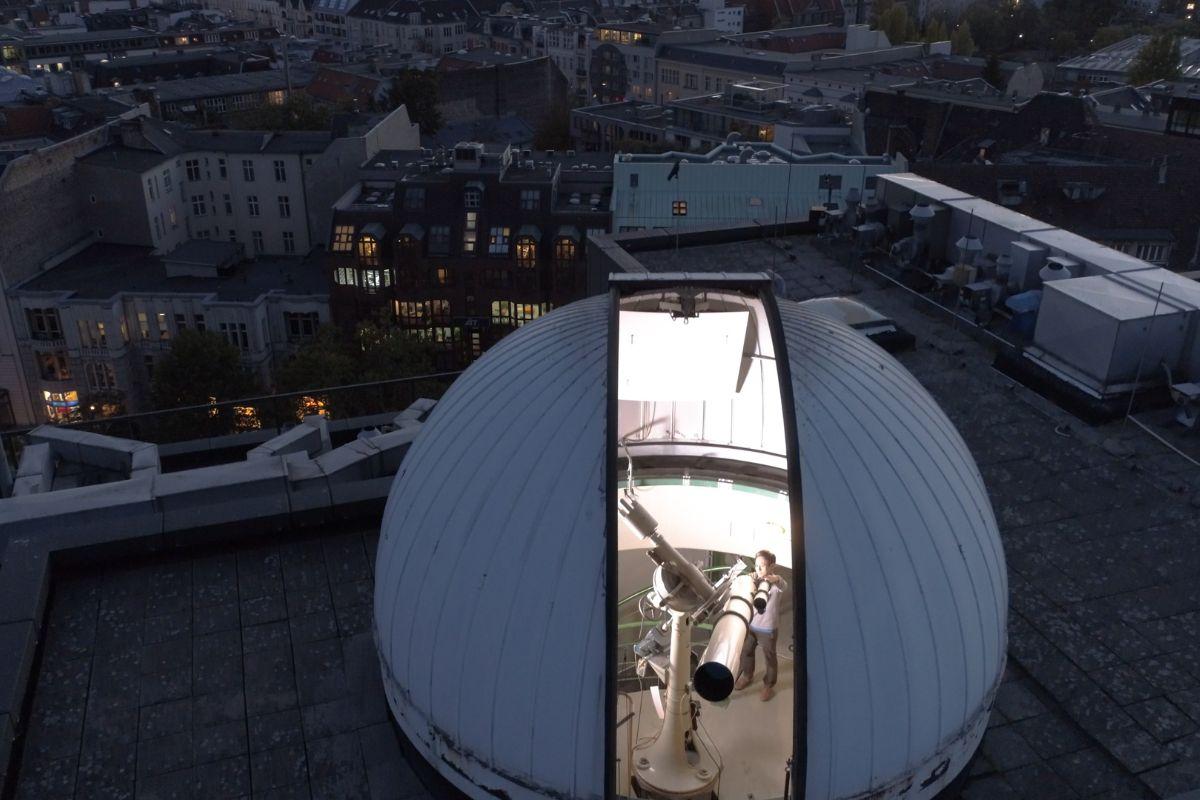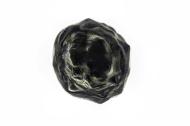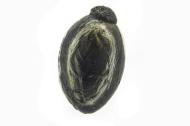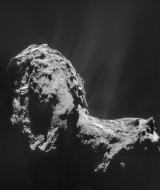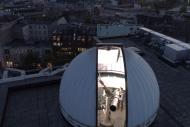Origin of micrometeorites determined for the first time using complex computer simulations and experiments
Citizen scientists can collect micrometeorites from the roofs of their homes and, with a little practice, identify them under a light microscope. The most seasoned among them joined forces with a team of researchers from TU Berlin, the Museum für Naturkunde Berlin, and other international scientists to determine where two micrometeorites had originated in the solar system – and that with a high degree of certainty. Both micrometeorites were in dust collected from the roof of the Eugene Paul Wigner Physics Building at TU Berlin. This study was the first to use a computer simulation that factors in a variety of possible orbits, particle properties, and the influence of cosmic rays on micrometeorites. The data from this computer simulation was compared with measurements of the micrometeorites in the Vienna Environmental Research Accelerator (VERA) at the University of Vienna to determine their origin.
Scott Peterson is a US army veteran, chemical engineering student in Minneapolis, and stay-at-home dad to his son. He also happens to be one of the most accomplished micrometeorite collectors in the world. This community has been growing ever since Norwegian jazz musician and citizen scientist Jon Larsen, in collaboration with Imperial College London, first demonstrated in 2015 that micrometeorites are not only found in remote places like the ocean floor and Antarctic ice, but also right on the roofs of our homes.
Citizen scientist identifies micrometeorite
"We asked Scott to take a look at our samples because he really has the sharpest eye for identifying micrometeorites under a microscope," says Dr. Jenny Feige, who conducts research into cosmic dust funded by a European Research Council Starting Grant. She previously worked at the Zentrum für Astronomie und Astrophysik (ZAA) at TU Berlin before moving to the Museum für Naturkunde Berlin, where further projects exploring micrometeorites are carried out in collaboration with citizen scientists. Prior to Scott Peterson's analysis, researchers from TU Berlin had climbed onto the roof of the Physics Building with the telescope dome to sweep up debris from the corners. "Everything we collect is soaked in water to get rid of tiny leaves and similar dirt. The sediment is then heated to 600 degrees to eliminate all microbes and other organic material. The material is then sifted, and the search for micrometeorites begins," says Feige.
Noses and tortoise shells
The sample contained innumerable spheres between 100 and 500 micrometers in size, the vast majority of which were declared "anthropogenic contaminants" – i.e. originating from human activities such as welding, fireworks, or simply metal abrasion from road traffic. In the very last portion of the sample, Scott Peterson did indeed find two micrometeorites, each of which could be categorized into a specific class based on their characteristic structures. These structures are formed when cosmic dust particles hurtle into the Earth's atmosphere and are subsequently decelerated and heated by friction with the air particles until they melt. After shedding an average of 90% of their mass, the rest of the particle crystallizes as it cools, depending on the angle and speed at which it enters the atmosphere, its composition, and the ambient conditions.
Due to the specific crystallization process it underwent, one micrometeorite bears a visual resemblance to a tortoise shell. Meanwhile in the other, the nickel and iron had separated from the rest of the elements as it melted, only to solidify as an extra globule on the micrometeorite as it cooled. "From this micrometeorite's 'nose' we can even determine how it entered the atmosphere, namely globule first," says Feige.
Micrometeorites can tell us about the conditions in the Solar System
"It is still a tremendous challenge for science to determine where micrometeorites found on Earth come from," says Dr. Beate Patzer, theoretical astrophysicist from the ZAA at TU Berlin. "But it is valuable information, because micrometeorites can come from very different parts of our Solar System with very different conditions. The Earth catches around 100 tons of mostly interplanetary dust per day. Micrometeorites are much more abundant than larger meteorites, so we could use them to collect far more data and learn a lot about our Solar System in the process."
Flight time to Earth
One method used to determine the origin of a micrometeorite is to analyze long-lived, radioactive isotopes that have formed on it during its journey through space from exposure to the cosmic radiation that is ubiquitous in outer space. "It is possible to determine the flight time the extraterrestrial dust particles had to reach Earth – and thus where in the Solar System they came from – based on the ratio of different isotopes with various half-lives and a physical model that describes the formation of these isotopes," says Patzer.
First time using computer simulations for analysis
"As a first in the field, we have created a complex computer simulation for this analysis that factors in possible orbits of the interplanetary dust particles, the size of the dust grains, their composition and density, radiation profiles from the Sun and cosmic rays from interstellar space, evaporation rates as they enter the Earth's atmosphere, and a host of other parameters," says Jenny Feige. The researchers focused on the radioactive isotopes aluminum-26 and beryllium-10.
To measure the very small amounts of isotopes in the tiny micrometeorites, the research team worked with the VERA particle accelerator facility in Vienna. The "accelerator mass spectrometry" performed there sorts the chemical elements not only according to their mass, but also according to the number of protons in their nucleus. This makes it possible to clearly identify the isotopes.
Tortoises from the far reaches of the solar system
The concentrations of aluminum-26 and beryllium-10 in the micrometeorites were then compared with the results of the computer simulation, which predicts the accumulation of these radioisotopes in the micrometeorites depending on the time of flight, and thus the place of origin in space. The origin of six micrometeorites collected at other sites remained unclear; however, six other micrometeorites could be assigned to an original site with a high degree of certainty, including the two found on the roof of TU Berlin: The micrometeorite with the tortoise shell pattern comes from the Outer Solar System and could have separated from comets passing by Jupiter or from rocky material in the Kuiper belt – at a distance of about 40 times the distance between the Earth and the Sun. Meanwhile the micrometeorite with the "nose" comes from the Inner Solar System, from near-Earth objects or even objects as far away as the asteroid belt between Mars and Jupiter.
"With this result, we were able to demonstrate the fundamental suitability of our method," says Jenny Feige. Going forward, the method will make it possible for us to learn even more about the cosmos through micrometeorites. "The micrometeorites on the roofs of our homes are particularly valuable, because we can pinpoint their time on earth very precisely: They cannot be older than the roof itself. For meteorites found on the ocean floor or in Antarctica, there's no way to prove that they haven't been there for millions of years, making the results more uncertain."
Publikation: J. Feige et al., "Transport of dust across the Solar System: Constraints on the spatial origin of individual micrometeorites from cosmic-ray exposure," Philosophical Transactions of the Royal Society A: Mathematical, Physical and Engineering Sciences, vol. 382, no. 2273, Jun. 2024. https://doi.org/10.1098/rsta.2023.0197
Pressebilder
Image 1: Micrometeorite with tortoise shell pattern © TU Berlin
Micrometeorite with tortoise shell pattern created by special crystallization processes in the Earth's atmosphere. It is very likely from the Outer Solar System and could have separated from comets passing by Jupiter or from rocky material in the Kuiper belt – at a distance of about 40 times the distance between the Earth and the Sun.
Image 2: Micrometeorite with a metallic pearl © TU Berlin
Micrometeorite with a metallic pearl on its periphery. It was formed after the nickel and iron had separated from the rest of the elements as it melted and solidified. These metals formed an extra globule on the micrometeorite as it cooled. It reveals how the micrometeorite entered the atmosphere, namely globule first.
Image 3: Roof of the TU Berlin physics building © Philipp Arnoldt, TU Berlin
You can not only look into space with a telescope on the roof of the Eugene Paul Wigner Physics building at TU Berlin. Right nearby, researchers found two micrometeorites in the debris on the ground. One of them is likely to be from the edge of our Solar System.
Image 4: Churyumov-Gerasimenko © ESA
Comet 67P/Churyumov-Gerasimenko, photographed on 20 November 2014 by the Rosetta spacecraft of the European Space Agency. Rosetta was only 31 kilometers away from the comet when it captured the image. The comet repeatedly emits fountains of gas and dust, especially when it is close to the Sun. The dust particles could then land as micrometeorites on the Earth.
